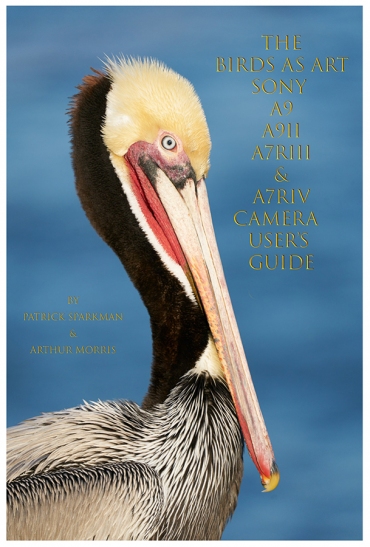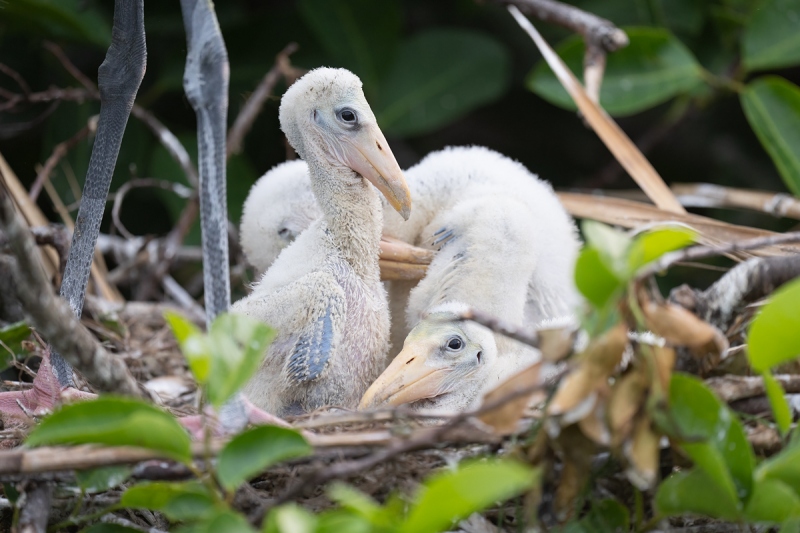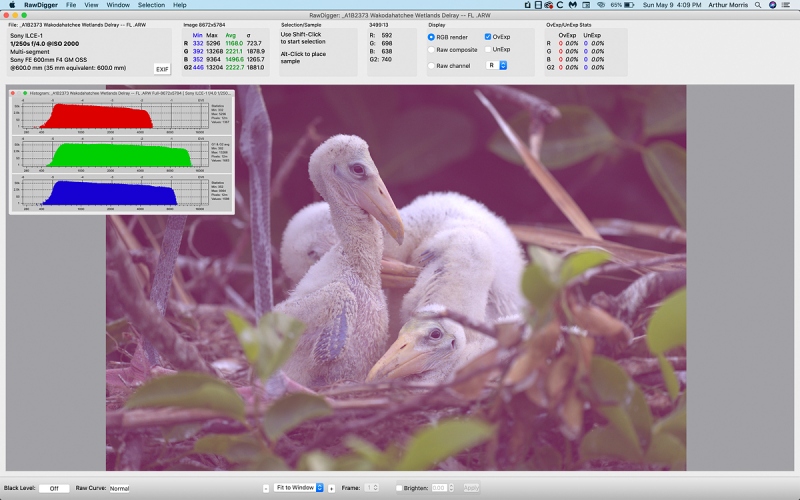What’s Up?
I had a great morning session photographing birds at ILE on Sunday, with lots of variety. In addition to the baby crane family, I got some nice stuff on Black-necked Stilt, Black-bellied Whistling Duck, and, my first-ever ILE images of a drake Wood Duck. I did get my feet wet.
Yesterday afternoon I created a Camtasia video for the SONY Alpha a1 Set-up and Info group. The ten-minute video details the use of the beyond amazing AF Method, Tracking: Expand Spot. While I still use Wide for birds in flight and in action with the a1, but Tracking: Expand Spot has become my go-to AF Method for birds perched or on the ground, still or in motion. The trick us understanding exactly what it does and how to use it. For information on joining the group, scroll down in the blog post here.
I guess that blurs are like fine wine in that you need to develop a taste for them. Thanks to all who commented, even those who picked A- I hate blurs. I would delete both of today’s featured images. That said, the Cypress tree blur is one of my very favorite images of all time, surely in the top 100. But then again, I hate all red wines …
Today is Monday 10 May 2021. Anita North and I are headed to Fort DeSoto for an overnight stay with three photo sessions. The forecast if pretty good: partly cloudy with a breeze from the south southeast. Wherever you are, and whatever you are doing, I hope that you have a great day.
This blog post took more than two hours to prepare, and makes 137 straight days with a new one. Please remember that if an item — a Delkin flash card, or a tripod head, for example, that is available from B&H and/or Bedfords and is also available in the BAA Online Store, it would be great if you opt to purchase from us. We will match any price. Please remember also to use my B&H affiliate links or to save 3% at Bedfords by using the BIRDSASART discount code at checkout. Doing either often earns you free guides and/or discounts. And always earns my great appreciation.
Coincidentally, via e-mail from Alpha a1 Group member Craig Elson this morning:
Artie – looking/reading through the Pleasing Blurs e-book that you did w/ Denise, I had to just stop and write to tell you how stunning Cypress Tree in Swamp, Lake Martin 2005 is!! Can’t recall a better vertical pan-blur ever; it is just gorgeous.
Please Remember
With income from IPTs greatly reduced, please, if you enjoy and learn from the blog, remember to use one of my two affiliate programs when purchasing new gear. Doing so just might make it possible for me to avoid having to try to get a job as a Walmart greeter and will not cost you a single penny more. And if you use Bedfords and remember to enter the BIRDSASART code at checkout, you will save 3% on every order and enjoy free second-day air shipping. In these crazy times — I am out at least forty to sixty thousand dollars so far due to COVID 19 (with lots more to come) — remembering to use my B&H link or to shop at Bedfords will help me out a ton and be greatly appreciated. Overseas folks who cannot order from the US because of import fees, duties, and taxes, are invited to help out by clicking here to leave a blog thank you gift if they see fit.
|
|
|
145 sold to rave reviews. The SONY e-Guide by Patrick Sparkman and Arthur Morris |
The Sony Camera User’s e-Guide (and Videos)
Folks new to SONY receive who are in the A1 group receive a free copy of this guide as many of the a1 settings mimic the settings in previous SONY bodies.
Click here to purchase the guide with one Camera Set-up Video. Be sure to e-mail us by clicking here to specify your camera body so that we can send you a link for the correct video.
Click here to purchase the guide with two Camera Set-up Videos. Be sure to e-mail us by clicking here to specify your two camera bodies so that we can send you links for the correct videos.
Click here to learn more about the SONY e-Guide.
Folks who have used my B&H affiliate links or purchased their SONY gear are invited to e-mail for discount information.
New and Better Bedfords Discount Policy!
You can now save 3% on all of your Bedfords photo gear purchases by entering the BIRDSASART coupon code at checkout. Your discount will be applied to your pre-tax total. In addition, by using the code you will get 2nd day air shipping via Fed Ex.
Grab a Nikon AF-S Teleconverter TC-14E III and save $14.99. Purchase a Canon EOS R5 and your discount will be $116.97. Purchase a Sony FE 600mm f/4 GM OSS lens and save a remarkable $389.94! Your Bedford’s purchase no longer needs to be greater than $1,000.00 for you to receive a discount. The more you spend, the more you save.
Money Saving Reminder
Many have learned that if you need a hot photo item that is out of stock at B&H and would enjoy free second-day air shipping, your best bet is to click here, place an order with Bedfords, and enter the coupon code BIRDSASART at checkout. If an item is out of stock, contact Steve Elkins via e-mail or on his cell phone at (479) 381-2592 (Central time). Be sure to mention the BIRDSASART coupon code and use it for your online order to save 3% and enjoy free 2nd-day air shipping. Steve has been great at getting folks the hot items that are out of stock at B&H and everywhere else. The wait lists at the big stores can be a year or longer for the hard to get items. Steve will surely get you your gear long before that. For the past year, he has been helping BAA Blog folks get their hands on items like the SONY a9 ii, the SONY 200-600 G OSS lens, the Canon EOS R5, the Canon RF 100-500mm lens, and the Nikon 500mm PF. Steve is personable, helpful, and eager to please.


Gear Questions and Advice
Too many folks attending BAA IPTs (remember those?) and dozens of photographers whom I see in the field and on BPN, are–out of ignorance–using the wrong gear especially when it comes to tripods and more especially, tripod heads… Please know that I am always glad to answer your gear questions via e-mail
|
|
|
This image was created on 8 May 2021 at Wakodahatchee Wetlands, Delray, FL. I used the Induro GIT 304L/Levered-clamp FlexShooter Pro-mounted Sony FE 600mm f/4 GM OSS lens and The One, the Sony Alpha 1 Mirrorless digital camera. ISO 2000. Exposure determined via Zebras with ISO on the rear dial: 1/250 sec. at f/4 (wide open) in Manual mode. AWB at 6:59am in the shade on a then-cloudy morning. Tracking: Expand Spot/AF-C was active at the moment of exposure and performed perfectly. Click on the image to see a larger version. Image #1: Wood Stork chicks in nest |
The Insane (?) Tripod Set-up
The two lowest nests were just above eye level while standing on the boardwalk. Needing to get higher for any chance of success, and needing to be at f/4 because of the low light, I placed the two back legs of my tripod on the bench that I was standing on and placed the shortened front leg of the tripod on the railing of the boardwalk. All that was done before mounting the big lens. After that as done, all of my movements were made very slowly and very carefully.
If …
If you like today’s featured image, please take a moment to let us know your favorite part of the photo. I have two that I will share with you here soon.
Rookeries are Cluttered, Messy Places … And So are Wood Stork Nests!
Yes, rookeries are cluttered, messy places and so are Wood Stork nests. So what are you gonna do about it?
1- Isolate your subject or subjects using long lenses to reduce the effects of the clutter. Once things brightened up a bit, I added first the 1.4XTC, and then went to the 2X.
2- Choose your perspectives very carefully while trying to use the jumbled of sticks and twigs in the nests as frames.
3- Working with direct sun on the nests makes your job many times harder — pre-dawn, shade, and cloudy bright help to reduce the contrast.
4- Work to get the right exposure to reduce the noise in the dark areas as much as possible. Using SONY Zebras when setting the exposure parameters is like cheating. It is child’s play to create perfect or near-perfect exposures every frame in all lighting conditions. When the light is changing I actually feel sorry for folks using systems that do not offer Zebras. Learn how to use them properly in the SONY e-Guide by Patrick Sparkman and Arthur Morris. (Scroll down for details.)
5- As always, pay attention to head angle, image design, and sharpness.
6- Attempting to remove the sticks and whitewash on images like this is a fruitless endeavor, and if you were successful, the result would look totally unrealistic. With this image I removed four small obtrusive specks and resisted the urge to proceed. I opted to go with 7 below …
7- Embrace the mess by concentrating on the cuteness, strangeness, (or the ugliness) of the chicks.
|
|
Image #1A: RawDigger Screen Capture for the Wood Stork chicks in nest image |
RawDigger
Clicking on the screen capture to enlarge it and better see the histogram. Note that the G channel is 2/3 of the way between the 8000 line and the 16000 line, in short, another perfect exposure.
RawDigger — not for the faint of heart …
Nothing has helped me learn to create perfect exposures to the degree that RawDigger has. I think that many folks are reluctant to learn that most of their images are underexposed by one or more full stops and that highlight warnings in Photoshop, Lightroom, Capture One, and your in-camera histogram are bogus as they are based on the embedded JPEGs. Only your raw files tell the truth all the time. Heck, I resisted RawDigger for several years … Once you get over that feeling, RawDigger can become your very best exposure friend no matter what system you are using. On the recent IPTs and In-the-Field sessions, we have demonstrated that fact. Convincingly.
The RawDigger (pink) Adapted Histogram
In the RawDigger e-Guide, you will learn exactly how to set up the Adapted “pink” RawDigger Histogram and how to use it to quickly and easily evaluate the exposure or raw file brightness of images from all digital cameras currently in use. RawDigger was especially helpful to me as I struggled with R5 exposures and learned my new camera body, the Sony Alpha a1.
|
|
RawDigger e-Guide with Two Videos |
The RawDigger e-Guide with Two Videos
by Arthur Morris with Patrick Sparkman
The RawDigger e-Guide was created only for serious photographers who wish to get the absolute most out of their raw files.
Patrick and I began work on the guide in July 2020. At first we struggled. We asked questions. We learned about Max-G values. We puzzled as to why the Max G values for different cameras were different. IPT veteran Bart Deamer asked lots of questions that we could not answer. We got help from RawDigger creator Iliah Borg. We learned. In December, Patrick came up with an Adapted Histogram that allows us to evaluate the exposures and raw file brightness for all images created with all digital camera bodies from the last two decades. What we learned each time prompted three complete beginning to end re-writes.
The point of the guide is to teach you to truly expose to the mega-Expose-to-the-Right so that you will minimize noise, maximize image quality, best utilize your camera’s dynamic range, and attain the highest possible level of shadow detail in your RAW files in every situation. In addition, your properly exposed RAW files will contain more tonal information and feature the smoothest possible transitions between tones. And your optimized images will feature rich, accurate color.
We teach you why the GREEN channel is almost always the first to over-expose. We save you money by advising you which version of RawDigger you need. We teach you how to interpret the Max G values for your Canon, Nikon, and SONY camera bodies. It is very likely that the Shock-your-World section will shock you. And lastly — thanks to the technical and practical brilliance of Patrick Sparkman — we teach you a simple way to quickly and easily evaluate your exposures and raw file brightness using an Adapted RawDigger histogram.
The flower video takes you through a session where artie edits a folder of images in Capture One while checking the exposures and Max-G values in RawDigger. The Adapted Histogram video examines a series of recent images with the pink histograms and covers lots of fine points including and especially how to deal with specular highlights. The directions for setting up the Adapted Histogram are in the text.
If we priced this guide based on how much effort we put into it, it would sell it for $999.00. But as this guide will be purchased only by a limited number of serious photographers, we have priced it at $51.00. You can order yours here in the BAA Online Store.
Typos
With all blog posts, feel free to e-mail or to leave a comment regarding any typos or errors.



















Artie – I also love the featherless neck of these funny-looking babies.
I know exactly the bench/railing you set up on – I did the same 5 yrs ago – but a GBH nest was there. In the first covered pavilion along the boardwalk, on the right?
Yes, Wokodhatchee is completely over-run with wood storks. I hadn’t been there for a few years before spring 2021, and almost all the GBH, cattle egret, and Great Egret nests were gone, replaced by stork after stork (after stork).
Question: re the “amazing AF Method, Tracking: Expand Spot” – is there any kind of equivalent on the Nikon D850 ?
The “Pleasing Blurs” guide is amazing! Thank you! Lyn
Hi Lynn,
Thanks for leaving a comment. Yes, that is the same bench.
As for “over-run with Wood Storks,” let’s not forget that Wood Stork is protected as a Threatened species by the Federal Endangered Species Act and as a Federally-designated Threatened species by Florida’s Endangered and Threatened Species Rule. And that Great Blue Heron, and Great and Cattle Egrets are not.
with love, artie
Hi Lyn,
Sorry that I missed your D850AF question. The short answer is “No.” They do offer a full screen AF pattern — I do not remember the name. While the AF points do dance around it does not track anything …
with love, a
I love Wakodahatchee, although I haven’t been there since 2001. I had a blast shooting birds with my Nikon F4 and 300mm Nikkor lens! I wonder if, and how much, it has changed since then.
I like the almost bare skin on the wing of the chick in the middle. I also like the wrinkles in this chick’s neck — he looks like a little old man.